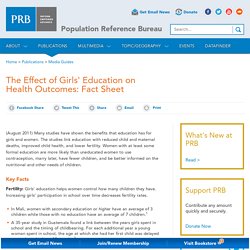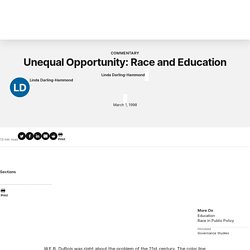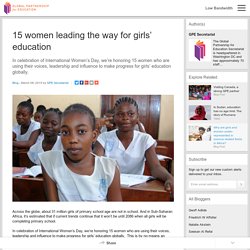

Sarah Previlon
The Effect of Girls' Education on Health Outcomes: Fact Sheet. (August 2011) Many studies have shown the benefits that education has for girls and women.

The studies link education with reduced child and maternal deaths, improved child health, and lower fertility. Women with at least some formal education are more likely than uneducated women to use contraception, marry later, have fewer children, and be better informed on the nutritional and other needs of children. Fertility: Girls' education helps women control how many children they have. Increasing girls' participation in school over time decreases fertility rates. In Mali, women with secondary education or higher have an average of 3 children while those with no education have an average of 7 children.1 A 35-year study in Guatemala found a link between the years girls spent in school and the timing of childbearing. Maternal Health: Increasing girls' access to education improves maternal health.
Unequal Opportunity: Race and Education. W.E.B.

DuBois was right about the problem of the 21st century. The color line divides us still. In recent years, the most visible evidence of this in the public policy arena has been the persistent attack on affirmative action in higher education and employment. From the perspective of many Americans who believe that the vestiges of discrimination have disappeared, affirmative action now provides an unfair advantage to minorities. From the perspective of others who daily experience the consequences of ongoing discrimination, affirmative action is needed to protect opportunities likely to evaporate if an affirmative obligation to act fairly does not exist. At the center of these debates are interpretations of the gaps in educational achievement between white and non-Asian minority students as measured by standardized test scores. Get daily updates from Brookings The Nature of Educational Inequality What Difference Does it Make?
When Opportunity Is More Equal What Can Be Done? You Won't Believe How Many Countries Still Won't Allow Women The Right To Education. Growing up in a privileged society, it's easy to take certain freedoms for granted.

We quickly forget that access to a quality education is not universal, especially for the women of the world. There are well over 20 prominent nations, which continue to discriminate against females by preventing them from learning. 15 women leading the way for girls’ education. Across the globe, about 31 million girls of primary school age are not in school.

And in Sub-Saharan Africa, it’s estimated that if current trends continue that it won’t be until 2086 when all girls will be completing primary school. In celebration of International Women’s Day, we’re honoring 15 women who are using their voices, leadership and influence to make progress for girls’ education globally. This is by no means an exhaustive list – just a few out of millions of women who are helping make change happen. 1. Michelle Bachelet, President of Chile During her second non-consecutive term, President Bachelet in 2014 ushered through a far-reaching education reform program that raised the government’s investment in public education. 2. By daring to go to school as a young teen, Malala defied Pakistani extremists and their violent attacks and became a global icon for the importance of educating girls. 3. 4.
Through her philanthropy and advocacy at the Graça Machel Trust, Ms. The Trouble With Bright Girls. Successful women know only too well that in any male-dominated profession, we often find ourselves at a distinct disadvantage.

We are routinely underestimated, underutilized, and even underpaid. Studies show that women need to perform at extraordinarily high levels, just to appear moderately competent compared to our male coworkers. But in my experience, smart and talented women rarely realize that one of the toughest hurdles they'll have to overcome to be successful lies within. We judge our own abilities not only more harshly, but fundamentally differently, than men do. Understanding why we do it is the first step to righting a terrible wrong. Chances are good that if you are a successful professional today, you were a pretty bright fifth grade girl. She found that bright girls, when given something to learn that was particularly foreign or complex, were quick to give up--and the higher the girls' IQ, the more likely they were to throw in the towel.
Why does this happen? Girl Rising. A collaboration with the Pearson Foundation Girl Rising provides teachers with a unique opportunity to introduce students to the issues surrounding girls' education in the developing world, and it’s transformational power.

To help teachers learn about the girls’ education movement and effectively share the information with their students, the Pearson Foundation has created this standards-aligned curriculum. Using the curriculum, teachers can engage their students in meaningful, theme-based social studies, political science, math, economics, and language arts lessons by encouraging them to think about important political, cultural, historical, and geographic issues tied to educating girls — and about their role as global citizens and their responsibilities to their own communities. The curriculum addresses inquiries of global scope such as, “How do economies grow when girls are educated?” As well as very basic questions like, “How do parents keep their daughters safe and cared for?”